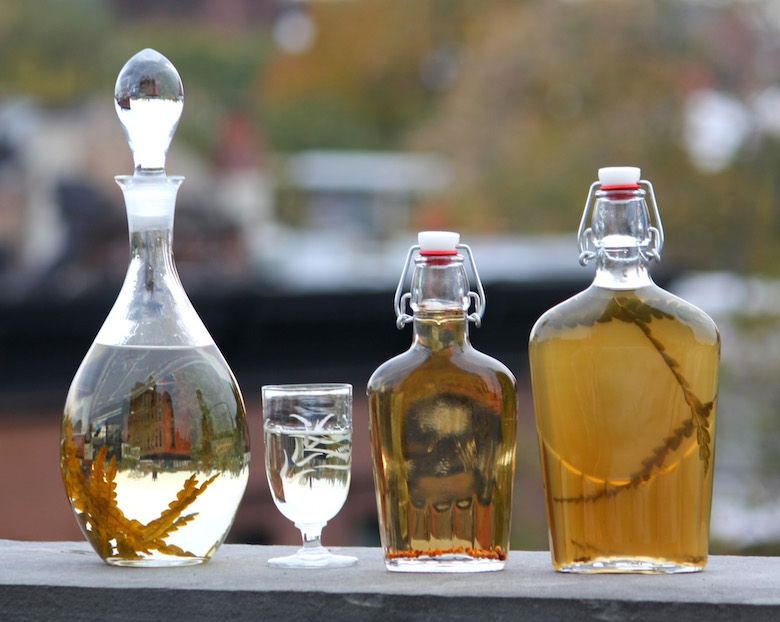It’s cold out. Short days have returned, and the four o’clock dark holds the suspense of a theater as the lights go down before the curtain rises. My foraging year has slowed to a crawl, apart from the occasional oyster mushroom score in Prospect Park. But now is the time for foragers to lean back and tell war stories over spoils that take months to mature: infusions.
I ward off the winter bogeyman by unsealing a bottle of sweet fern syrup and popping the cork on a chilled, sparkling blanc de blancs. Time for a sweet fern cocktail. We sip it on the cold roof beneath wheeling pigeons. Not a fern at all, the evocatively named Comptonia peregrina is related to bayberry (Myrica pensylvanica), one of my favorite leaves to forage. Both plants are native to the Northeast and belong to the fragrant family Myricaceae, but this slender, frond-like leaf is the more aromatic and sings of summertime: Hold it to your nose and, even without crushing, its aroma calls to mind mounds of fresh hay. In early fall I picked some slim branches near the East River and slipped 20 leaves into a simple syrup. In another bottle, more sweet fern floats like seaweed in a clear sea of gin.
Infusions are a way of stalling for time, of pressing “pause” while I decide what to do with this suggestive, optimistic scent. It is altogether new to me, a native South African. It is not the scent of camp, as it is for my friend Ellen; she grew up in New England, where bare summer legs crushed the plants growing thickly beside paths and carried the green fragrance inside. Native Americans used the leaves as an incense and for medicinal purposes (it is said to be an antidote to poison ivy), and it is also known as redneck reefer, for obvious reasons. But I don’t smoke, and need to buy time. Making a syrup, steeping the leaves for an hour, then straining and bottling it, allows me to think. And to taste. I have the whole of winter to arrive at something brilliant. As long as the blanc de blancs holds out.
As the weather turns cold, bright clusters of violet beautyberries hang like miniature Christmas decorations on bare shrubs in brownstone front gardens. Another Northeastern native, they’re very jammy when heated, and soon their fruity scent fills my kitchen. Their flavor falls somewhere between mahlab (the ground kernels of Prunus mahaleb) and overcooked plum jam. I use them dried as a spice in butter cookies, but I am curious to see whether their essence can be captured in Stolichnaya.
Bayberry turns the vodka a sepia green. Early summer Juneberries (Amelanchier species) have been strained from their Calvados, which is now very almondy. I will make jelly from the spirit-saturated berries. Cognac and spicebush (Lindera benzoin) berries have become acquainted.
Winter will be just fine. On with the snow—I mean, show.
Note: Comptonia peregrina is listed as threatened in some states. Use only where it is renewable. Better yet, plant it.



